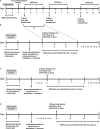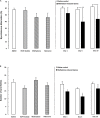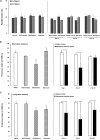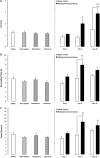Delay-Dependent Impairments in Memory and Motor Functions After Acute Methadone Overdose in Rats
- PMID: 30250433
- PMCID: PMC6139438
- DOI: 10.3389/fphar.2018.01023
Delay-Dependent Impairments in Memory and Motor Functions After Acute Methadone Overdose in Rats
Abstract
Methadone is used as a substitution drug for the treatment of opioid dependence and chronic pain. Despite its widespread use and availability, there is a serious concern with respect to the relative safety of methadone. The purpose of this study was to characterize how acute methadone overdose affects the cognitive and motor performance of naïve healthy rats. The methadone overdose was induced by administering an acute toxic dose of methadone (15 mg/kg; ip; the equivalent dose of 80% of LD50) to adolescent rats. Resuscitation using a ventilator pump along with a single dose of naloxone (2 mg/kg; ip) was administered following the occurrence of apnea. The animals which were successfully resuscitated divided randomly into three apnea groups that evaluated either on day 1, 5, or 10 post-resuscitation (M/N-Day 1, M/N-Day 5, and M/N-Day 10 groups) in the Y-maze and novel object memory recognition tasks as well as pole and rotarod tests. The data revealed that a single toxic dose of methadone had an adverse effect on spontaneous behavior. In addition, Recognition memory impairment was observed in the M/N-Day 1, 5, and 10 groups after methadone-induced apnea. Further, descending time in the M/N-Day 5 group increased significantly in comparison with its respective Saline control group. The overall results indicate that acute methadone-overdose-induced apnea produced delay-dependent cognitive and motor impairment. We suggest that methadone poisoning should be considered as a possible cause of delayed neurological disorders, which might be transient, in some types of memory or motor performance in naïve healthy rats.
Keywords: learning and memory performance; methadone; motor coordination; naloxone; overdose; rat.
Figures






Similar articles
-
Time-Dependent Changes in the Serum Levels of Neurobiochemical Factors After Acute Methadone Overdose in Adolescent Male Rat.Cell Mol Neurobiol. 2021 Nov;41(8):1635-1649. doi: 10.1007/s10571-020-00931-1. Epub 2020 Jul 25. Cell Mol Neurobiol. 2021. PMID: 32712727 Free PMC article.
-
Methadone vs. buprenorphine/naloxone during early opioid substitution treatment: a naturalistic comparison of cognitive performance relative to healthy controls.BMC Clin Pharmacol. 2007 Jun 12;7:5. doi: 10.1186/1472-6904-7-5. BMC Clin Pharmacol. 2007. PMID: 17565668 Free PMC article.
-
The effects of acute and chronic steady state methadone on memory retrieval in rats.Psychopharmacology (Berl). 2012 Jul;222(2):225-35. doi: 10.1007/s00213-012-2638-8. Epub 2012 Jan 19. Psychopharmacology (Berl). 2012. PMID: 22258154
-
Primary care management of opioid use disorders: Abstinence, methadone, or buprenorphine-naloxone?Can Fam Physician. 2017 Mar;63(3):200-205. Can Fam Physician. 2017. PMID: 28292795 Free PMC article. Review.
-
[Mechanisms of opioid-induced overdose: experimental approach to clinical concerns].Ann Pharm Fr. 2009 Sep;67(5):353-9. doi: 10.1016/j.pharma.2009.06.005. Epub 2009 Aug 3. Ann Pharm Fr. 2009. PMID: 19695371 Review. French.
Cited by
-
Combined effects of quetiapine and opioids: A study of autopsy cases, drug users and sedation in rats.Addict Biol. 2022 Sep;27(5):e13214. doi: 10.1111/adb.13214. Addict Biol. 2022. PMID: 36001431 Free PMC article.
-
Amphetamine Induces Oxidative Stress, Glial Activation and Transient Angiogenesis in Prefrontal Cortex via AT1-R.Front Pharmacol. 2021 May 3;12:647747. doi: 10.3389/fphar.2021.647747. eCollection 2021. Front Pharmacol. 2021. PMID: 34012397 Free PMC article.
-
Coenzyme Q10 Modulates Apoptotic Effects of Chronic Administration of Methadone on NMRI Mouse Hippocampus.Cell J. 2021 Oct;23(5):538-543. doi: 10.22074/cellj.2021.7384. Epub 2021 Oct 30. Cell J. 2021. PMID: 34837681 Free PMC article.
-
Neurocognitive impairments and brain abnormalities resulting from opioid-related overdoses: A systematic review.Drug Alcohol Depend. 2021 Sep 1;226:108838. doi: 10.1016/j.drugalcdep.2021.108838. Epub 2021 Jun 24. Drug Alcohol Depend. 2021. PMID: 34271512 Free PMC article.
-
The effect of a methadone-initiated memory reconsolidation updating procedure in opioid use disorder: A translational study.EBioMedicine. 2022 Nov;85:104283. doi: 10.1016/j.ebiom.2022.104283. Epub 2022 Sep 28. EBioMedicine. 2022. PMID: 36182773 Free PMC article. Clinical Trial.
References
LinkOut - more resources
Full Text Sources
Other Literature Sources
Research Materials

